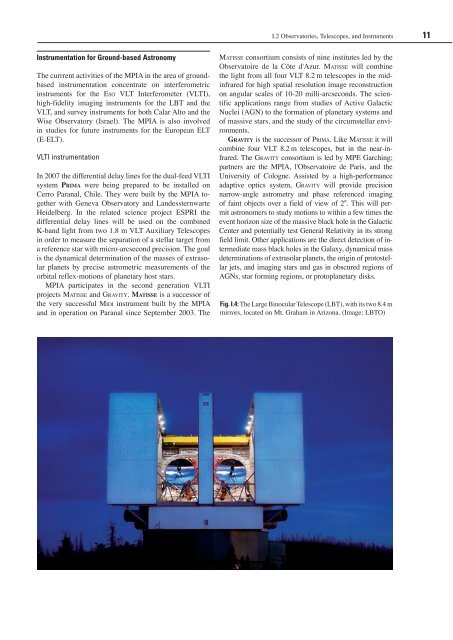Max Planck Institute for Astronomy - Annual Report 2007
Max Planck Institute for Astronomy - Annual Report 2007
Max Planck Institute for Astronomy - Annual Report 2007
Create successful ePaper yourself
Turn your PDF publications into a flip-book with our unique Google optimized e-Paper software.
Instrumentation <strong>for</strong> Ground-based <strong>Astronomy</strong><br />
The currrent activities of the MPIA in the area of groundbased<br />
instrumentation concentrate on interferometric<br />
instruments <strong>for</strong> the eso VLT Interferometer (VLTI),<br />
high-fidelity imaging instruments <strong>for</strong> the LBT and the<br />
VLT, and survey instruments <strong>for</strong> both Calar Alto and the<br />
Wise Observatory (Israel). The MPIA is also involved<br />
in studies <strong>for</strong> future instruments <strong>for</strong> the European ELT<br />
(E-ELT).<br />
VLTI instrumentation<br />
In <strong>2007</strong> the differential delay lines <strong>for</strong> the dual-feed VLTI<br />
system Pr i m a were being prepared to be installed on<br />
Cerro Paranal, Chile. They were built by the MPIA together<br />
with Geneva Observatory and Landessternwarte<br />
Heidelberg. In the related science project ESPRI the<br />
differential delay lines will be used on the combined<br />
K-band light from two 1.8 m VLT Auxiliary Telescopes<br />
in order to measure the separation of a stellar target from<br />
a reference star with micro-arcsecond precision. The goal<br />
is the dynamical determination of the masses of extrasolar<br />
planets by precise astrometric measurements of the<br />
orbital reflex-motions of planetary host stars.<br />
MPIA participates in the second generation VLTI<br />
projects maTisse and gr av iT y . matisse is a successor of<br />
the very successful mi D i instrument built by the MPIA<br />
and in operation on Paranal since September 2003. The<br />
I.2 Observatories, Telescopes, and Instruments 11<br />
maTisse consortium consists of nine institutes led by the<br />
Observatoire de la Côte d'Azur. maTisse will combine<br />
the light from all four VLT 8.2 m telescopes in the midinfrared<br />
<strong>for</strong> high spatial resolution image reconstruction<br />
on angular scales of 10-20 milli-arcseconds. The scientific<br />
applications range from studies of Active Galactic<br />
Nuclei (AGN) to the <strong>for</strong>mation of planetary systems and<br />
of massive stars, and the study of the circumstellar environments.<br />
Gr av i t y is the successor of Pr i m a. Like maTisse it will<br />
combine four VLT 8.2 m telescopes, but in the near-infrared.<br />
The gr av iT y consortium is led by MPE Garching;<br />
partners are the MPIA, l'Observatoire de Paris, and the<br />
University of Cologne. Assisted by a high-per<strong>for</strong>mance<br />
adaptive optics system, gr av iT y will provide precision<br />
narrow-angle astrometry and phase referenced imaging<br />
of faint objects over a field of view of 2. This will permit<br />
astronomers to study motions to within a few times the<br />
event horizon size of the massive black hole in the Galactic<br />
Center and potentially test General Relativity in its strong<br />
field limit. Other applications are the direct detection of intermediate<br />
mass black holes in the Galaxy, dynamical mass<br />
determinations of extrasolar planets, the origin of protostellar<br />
jets, and imaging stars and gas in obscured regions of<br />
AGNs, star <strong>for</strong>ming regions, or protoplanetary disks.<br />
Fig. I.4: The Large Binocular Telescope (LBT), with its two 8.4 m<br />
mirrors, located on Mt. Graham in Arizona. (Image: LBTO)

















